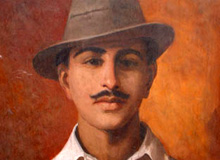Born: September 27, 1907
Passed Away: March 23, 1931
Contributions
 Bhagat Singh was among the prominent revolutionaries who shaped the base of a grand national movement. Following his execution, on March 23, 1931, the supporters and followers of Bhagat Singh regarded him as a "Shaheed", "martyr".
Bhagat Singh was among the prominent revolutionaries who shaped the base of a grand national movement. Following his execution, on March 23, 1931, the supporters and followers of Bhagat Singh regarded him as a "Shaheed", "martyr". Life
Bhagat Singh was born on 27 September 1907 at Banga in Lyallpur district (now Pakistan) to Kishan Singh and Vidya Vati. From his early childhood, Bhagat Singh was imbued with the family's spirit of patriotism. At the time of his birth, his father Kishan Singh was in jail. His uncle, Sardar Ajit Singh, was a great freedom fighter and established the Indian Patriots' Association. He was well-supported by his friend Syed Haidar Raza, in organizing the peasants against the Chenab Canal Colony Bill. Ajit Singh had 22 cases against him and was forced to flee to Iran. Bhagat Singh was considered to be one of the most influential revolutionaries of Indian Nationalist Movement. He became involved with numerous revolutionary organizations.
Kishan Singh enrolled Bhagat Singh in Dayanand Anglo Vedic High School. At a very young age, Bhagat Singh started following Non-Cooperation Movement called by Mahatma Gandhi. Bhagat Singh had openly defied the British and had followed Gandhi's wishes by burning the government-sponsored books. Following the violent incidents of "Chauri Chaura", Gandhi called for the withdrawal of the Non-Cooperation movement. Unhappy with the decision, Bhagat Singh, isolated himself from Gandhi's nonviolent action and joined the Young Revolutionary Movement.
He was pursuing B.A. examination when his parents planned to have him married. He vehemently rejected the suggestion and said that, if his marriage was to take place in Slave-India, my bride shall be only death." Singh later joined the Hindustan Republican Association, a radical group, later known as the Hindustan Socialist Republican Association. He returned to his home in Lahore after assurances from his parents that he would not be compelled to get married. He established contact with the members of the Kirti Kisan Party and started contributing regularly to its magazine, the "Kirti". In March 1926, the Naujawan Bharat Sabha was formed with Bhagat Singh, as its secretary.
On 30 October 1928, an all-parties procession, led by Lala Lajpat Rai, marched towards the Lahore railway station to protest against the arrival of the Simon Commission. Stopping the procession, police made a lathi charge at the activists. The confrontation left Lala Lajpat Rai with severe injuries and also led to his death. As an avenge to the death of Lala Lajpat Rai, Bhagat Singh and his associates plotted the assassination of Scott, the Superintendent of Police, believed to have ordered the lathi charge. The revolutionaries, mistaking J.P. Saunders, an Assistant Superintendent of Police, as Scott, killed him instead. Bhagat Singh quickly left Lahore to escape his arrest. To avoid recognition, he shaved his beard and cut his hair, a violation of the sacred tenets of Sikhism.

In response to the formulation of Defence of India Act, the Hindustan Socialist Republican Association planned to explode a bomb inside the assembly premises, where the ordinance was going to be passed. On April 8 1929 Bhagat Singh and Batukeshwar Dutt threw a bomb onto the corridors of the assembly and shouted 'Inquilab Zindabad!' The bomb was not meant to kill or injure anyone and therefore it was thrown away from the crowded place. Following the blasts both Bhagat Singh and Batukeshwar Dutt courted arrest
Trial and Death
The British authority, while interrogating them, came to know about their involvement in the murder of J. P. Saunders. Bhagat Singh, Rajguru, and Sukhdev were charged with the murder. Singh admitted to the murder and made statements against the British rule during the trial.
While in jail, Bhagat Singh found that the authorities were following a dual policy in treating the prisoners. The criminals of foreign origin were treated better than Indian political prisoners. As a protest, he along with some fellow prisoners declared to "go on hunger strike". The strike continued for over a month and finally the British had to accept before their conditions.
Bhagat Singh along with other revolutionaries found responsible for the Assembly bombing and murder of Saunders. On March 23, 1931, Bhagat Singh was hanged in Lahore with his fellow comrades Rajguru and Sukhdev. Singh was cremated at Hussainiwala on banks of Sutlej river.
